Organisational Behaviour: Culture, Power, Motivation in Teams
VerifiedAdded on 2022/12/26
|14
|4008
|88
Report
AI Summary
This report delves into organisational behaviour, examining the influence of organisational culture, power, and politics on team behaviour and performance within Marks and Spencer. It evaluates content and process motivation theories, such as Maslow's hierarchy of needs and Adam's equity theory, to understand how they contribute to organisational growth and success. The report differentiates between effective and ineffective teams, highlighting the importance of team roles and dynamics. Furthermore, it discusses key concepts and philosophies of organisational behaviour, providing a comprehensive overview of factors impacting employee motivation and team effectiveness in a business context. Desklib offers a variety of solved assignments and study tools for students.
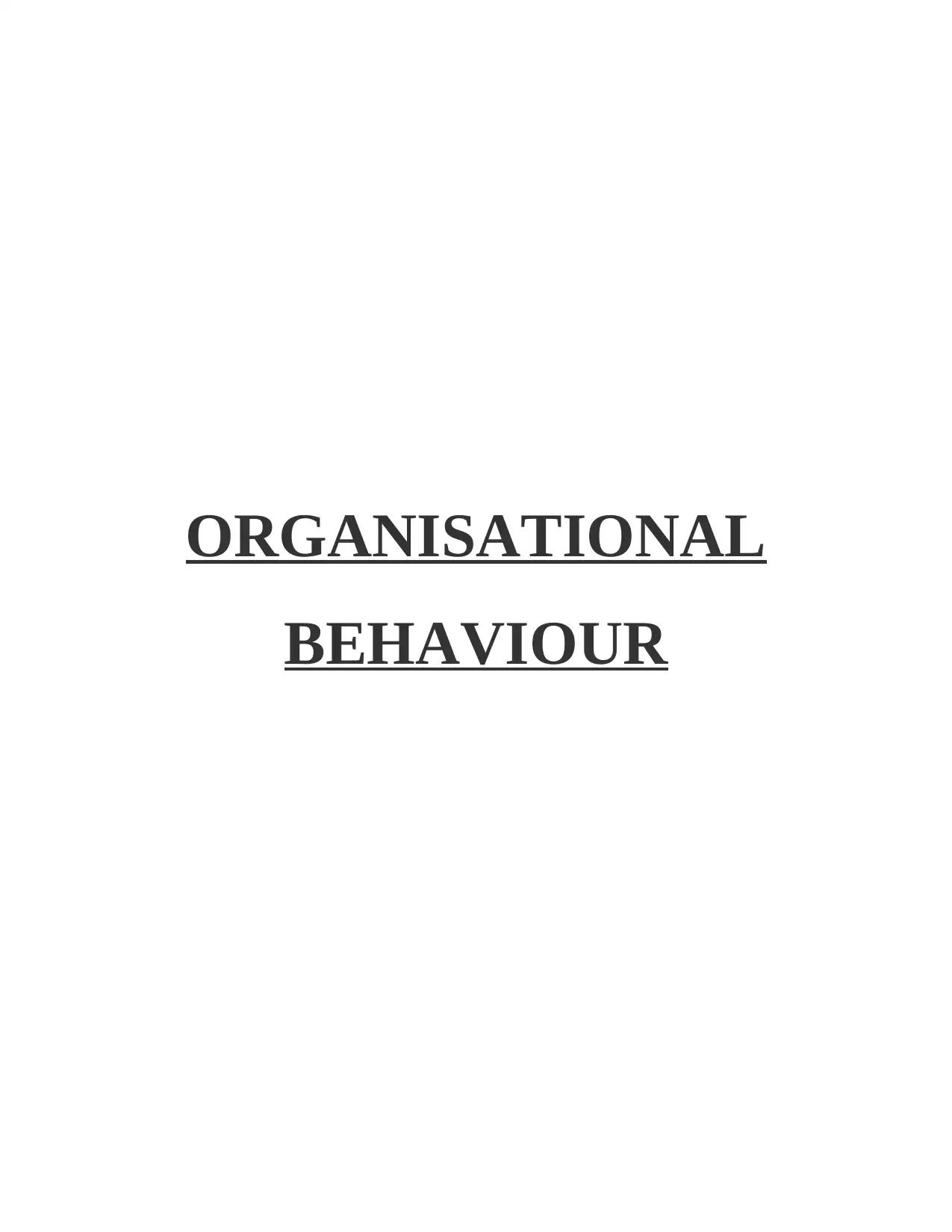
ORGANISATIONAL
BEHAVIOUR
BEHAVIOUR
Paraphrase This Document
Need a fresh take? Get an instant paraphrase of this document with our AI Paraphraser
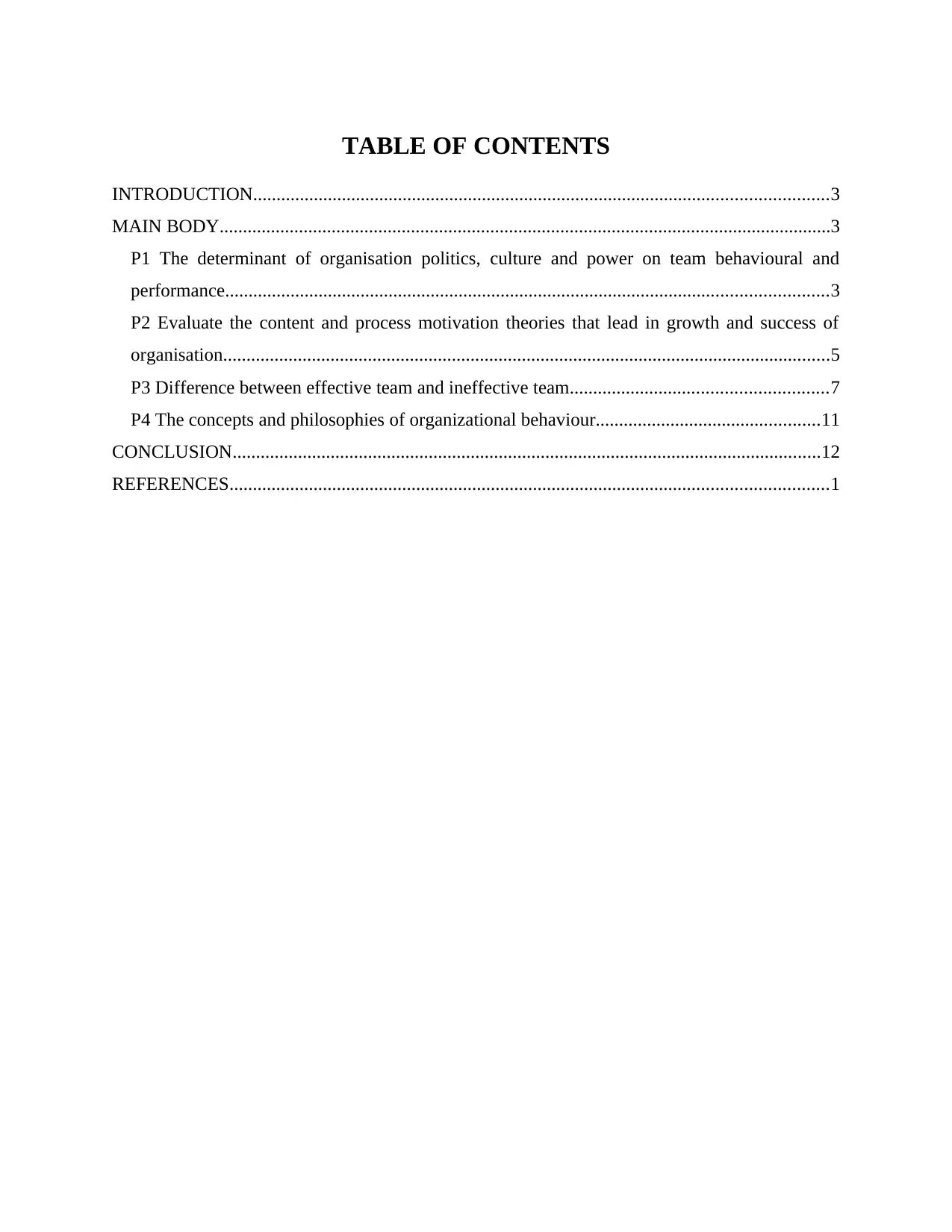
TABLE OF CONTENTS
INTRODUCTION...........................................................................................................................3
MAIN BODY...................................................................................................................................3
P1 The determinant of organisation politics, culture and power on team behavioural and
performance.................................................................................................................................3
P2 Evaluate the content and process motivation theories that lead in growth and success of
organisation..................................................................................................................................5
P3 Difference between effective team and ineffective team.......................................................7
P4 The concepts and philosophies of organizational behaviour................................................11
CONCLUSION..............................................................................................................................12
REFERENCES................................................................................................................................1
INTRODUCTION...........................................................................................................................3
MAIN BODY...................................................................................................................................3
P1 The determinant of organisation politics, culture and power on team behavioural and
performance.................................................................................................................................3
P2 Evaluate the content and process motivation theories that lead in growth and success of
organisation..................................................................................................................................5
P3 Difference between effective team and ineffective team.......................................................7
P4 The concepts and philosophies of organizational behaviour................................................11
CONCLUSION..............................................................................................................................12
REFERENCES................................................................................................................................1
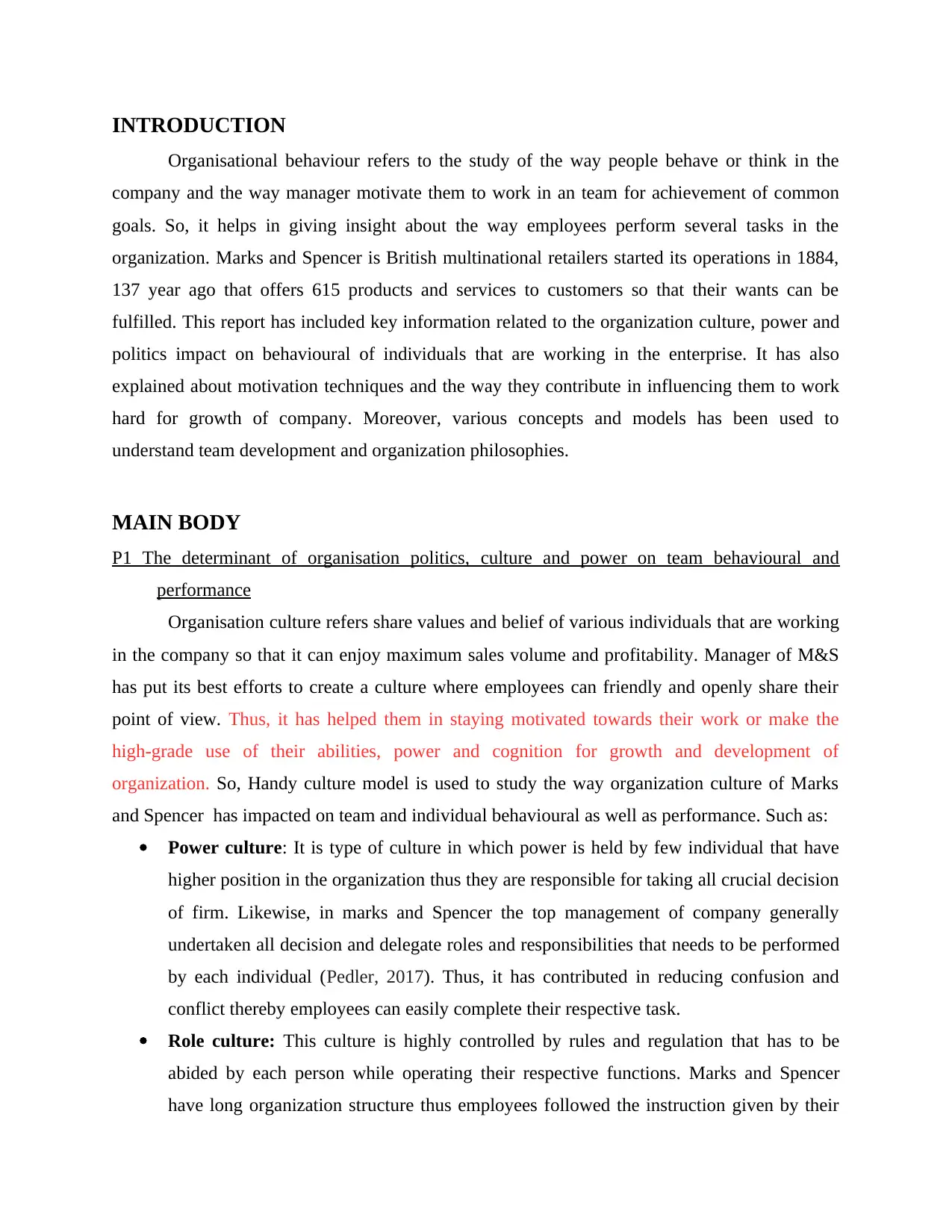
INTRODUCTION
Organisational behaviour refers to the study of the way people behave or think in the
company and the way manager motivate them to work in an team for achievement of common
goals. So, it helps in giving insight about the way employees perform several tasks in the
organization. Marks and Spencer is British multinational retailers started its operations in 1884,
137 year ago that offers 615 products and services to customers so that their wants can be
fulfilled. This report has included key information related to the organization culture, power and
politics impact on behavioural of individuals that are working in the enterprise. It has also
explained about motivation techniques and the way they contribute in influencing them to work
hard for growth of company. Moreover, various concepts and models has been used to
understand team development and organization philosophies.
MAIN BODY
P1 The determinant of organisation politics, culture and power on team behavioural and
performance
Organisation culture refers share values and belief of various individuals that are working
in the company so that it can enjoy maximum sales volume and profitability. Manager of M&S
has put its best efforts to create a culture where employees can friendly and openly share their
point of view. Thus, it has helped them in staying motivated towards their work or make the
high-grade use of their abilities, power and cognition for growth and development of
organization. So, Handy culture model is used to study the way organization culture of Marks
and Spencer has impacted on team and individual behavioural as well as performance. Such as:
Power culture: It is type of culture in which power is held by few individual that have
higher position in the organization thus they are responsible for taking all crucial decision
of firm. Likewise, in marks and Spencer the top management of company generally
undertaken all decision and delegate roles and responsibilities that needs to be performed
by each individual (Pedler, 2017). Thus, it has contributed in reducing confusion and
conflict thereby employees can easily complete their respective task.
Role culture: This culture is highly controlled by rules and regulation that has to be
abided by each person while operating their respective functions. Marks and Spencer
have long organization structure thus employees followed the instruction given by their
Organisational behaviour refers to the study of the way people behave or think in the
company and the way manager motivate them to work in an team for achievement of common
goals. So, it helps in giving insight about the way employees perform several tasks in the
organization. Marks and Spencer is British multinational retailers started its operations in 1884,
137 year ago that offers 615 products and services to customers so that their wants can be
fulfilled. This report has included key information related to the organization culture, power and
politics impact on behavioural of individuals that are working in the enterprise. It has also
explained about motivation techniques and the way they contribute in influencing them to work
hard for growth of company. Moreover, various concepts and models has been used to
understand team development and organization philosophies.
MAIN BODY
P1 The determinant of organisation politics, culture and power on team behavioural and
performance
Organisation culture refers share values and belief of various individuals that are working
in the company so that it can enjoy maximum sales volume and profitability. Manager of M&S
has put its best efforts to create a culture where employees can friendly and openly share their
point of view. Thus, it has helped them in staying motivated towards their work or make the
high-grade use of their abilities, power and cognition for growth and development of
organization. So, Handy culture model is used to study the way organization culture of Marks
and Spencer has impacted on team and individual behavioural as well as performance. Such as:
Power culture: It is type of culture in which power is held by few individual that have
higher position in the organization thus they are responsible for taking all crucial decision
of firm. Likewise, in marks and Spencer the top management of company generally
undertaken all decision and delegate roles and responsibilities that needs to be performed
by each individual (Pedler, 2017). Thus, it has contributed in reducing confusion and
conflict thereby employees can easily complete their respective task.
Role culture: This culture is highly controlled by rules and regulation that has to be
abided by each person while operating their respective functions. Marks and Spencer
have long organization structure thus employees followed the instruction given by their
⊘ This is a preview!⊘
Do you want full access?
Subscribe today to unlock all pages.

Trusted by 1+ million students worldwide
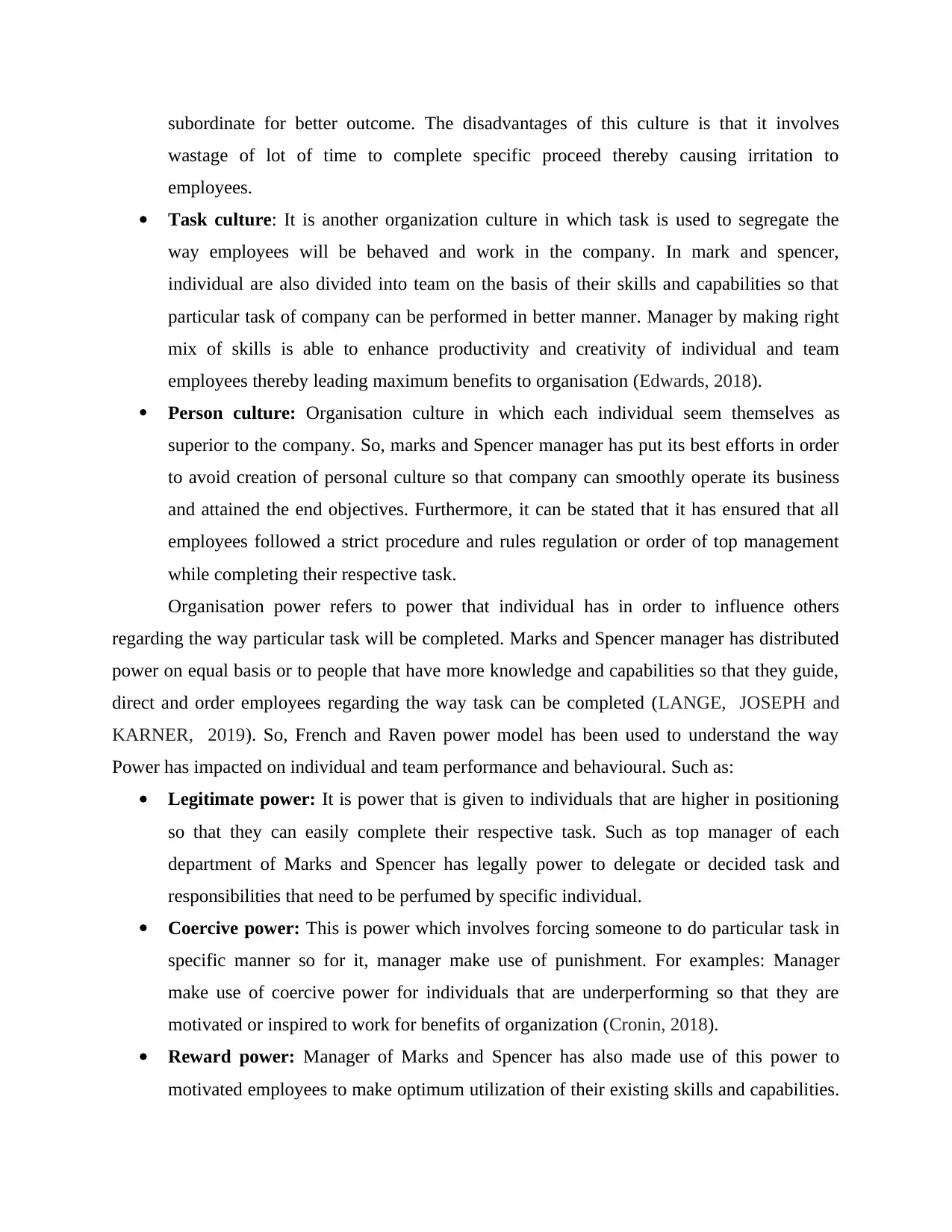
subordinate for better outcome. The disadvantages of this culture is that it involves
wastage of lot of time to complete specific proceed thereby causing irritation to
employees.
Task culture: It is another organization culture in which task is used to segregate the
way employees will be behaved and work in the company. In mark and spencer,
individual are also divided into team on the basis of their skills and capabilities so that
particular task of company can be performed in better manner. Manager by making right
mix of skills is able to enhance productivity and creativity of individual and team
employees thereby leading maximum benefits to organisation (Edwards, 2018).
Person culture: Organisation culture in which each individual seem themselves as
superior to the company. So, marks and Spencer manager has put its best efforts in order
to avoid creation of personal culture so that company can smoothly operate its business
and attained the end objectives. Furthermore, it can be stated that it has ensured that all
employees followed a strict procedure and rules regulation or order of top management
while completing their respective task.
Organisation power refers to power that individual has in order to influence others
regarding the way particular task will be completed. Marks and Spencer manager has distributed
power on equal basis or to people that have more knowledge and capabilities so that they guide,
direct and order employees regarding the way task can be completed (LANGE, JOSEPH and
KARNER, 2019). So, French and Raven power model has been used to understand the way
Power has impacted on individual and team performance and behavioural. Such as:
Legitimate power: It is power that is given to individuals that are higher in positioning
so that they can easily complete their respective task. Such as top manager of each
department of Marks and Spencer has legally power to delegate or decided task and
responsibilities that need to be perfumed by specific individual.
Coercive power: This is power which involves forcing someone to do particular task in
specific manner so for it, manager make use of punishment. For examples: Manager
make use of coercive power for individuals that are underperforming so that they are
motivated or inspired to work for benefits of organization (Cronin, 2018).
Reward power: Manager of Marks and Spencer has also made use of this power to
motivated employees to make optimum utilization of their existing skills and capabilities.
wastage of lot of time to complete specific proceed thereby causing irritation to
employees.
Task culture: It is another organization culture in which task is used to segregate the
way employees will be behaved and work in the company. In mark and spencer,
individual are also divided into team on the basis of their skills and capabilities so that
particular task of company can be performed in better manner. Manager by making right
mix of skills is able to enhance productivity and creativity of individual and team
employees thereby leading maximum benefits to organisation (Edwards, 2018).
Person culture: Organisation culture in which each individual seem themselves as
superior to the company. So, marks and Spencer manager has put its best efforts in order
to avoid creation of personal culture so that company can smoothly operate its business
and attained the end objectives. Furthermore, it can be stated that it has ensured that all
employees followed a strict procedure and rules regulation or order of top management
while completing their respective task.
Organisation power refers to power that individual has in order to influence others
regarding the way particular task will be completed. Marks and Spencer manager has distributed
power on equal basis or to people that have more knowledge and capabilities so that they guide,
direct and order employees regarding the way task can be completed (LANGE, JOSEPH and
KARNER, 2019). So, French and Raven power model has been used to understand the way
Power has impacted on individual and team performance and behavioural. Such as:
Legitimate power: It is power that is given to individuals that are higher in positioning
so that they can easily complete their respective task. Such as top manager of each
department of Marks and Spencer has legally power to delegate or decided task and
responsibilities that need to be perfumed by specific individual.
Coercive power: This is power which involves forcing someone to do particular task in
specific manner so for it, manager make use of punishment. For examples: Manager
make use of coercive power for individuals that are underperforming so that they are
motivated or inspired to work for benefits of organization (Cronin, 2018).
Reward power: Manager of Marks and Spencer has also made use of this power to
motivated employees to make optimum utilization of their existing skills and capabilities.
Paraphrase This Document
Need a fresh take? Get an instant paraphrase of this document with our AI Paraphraser
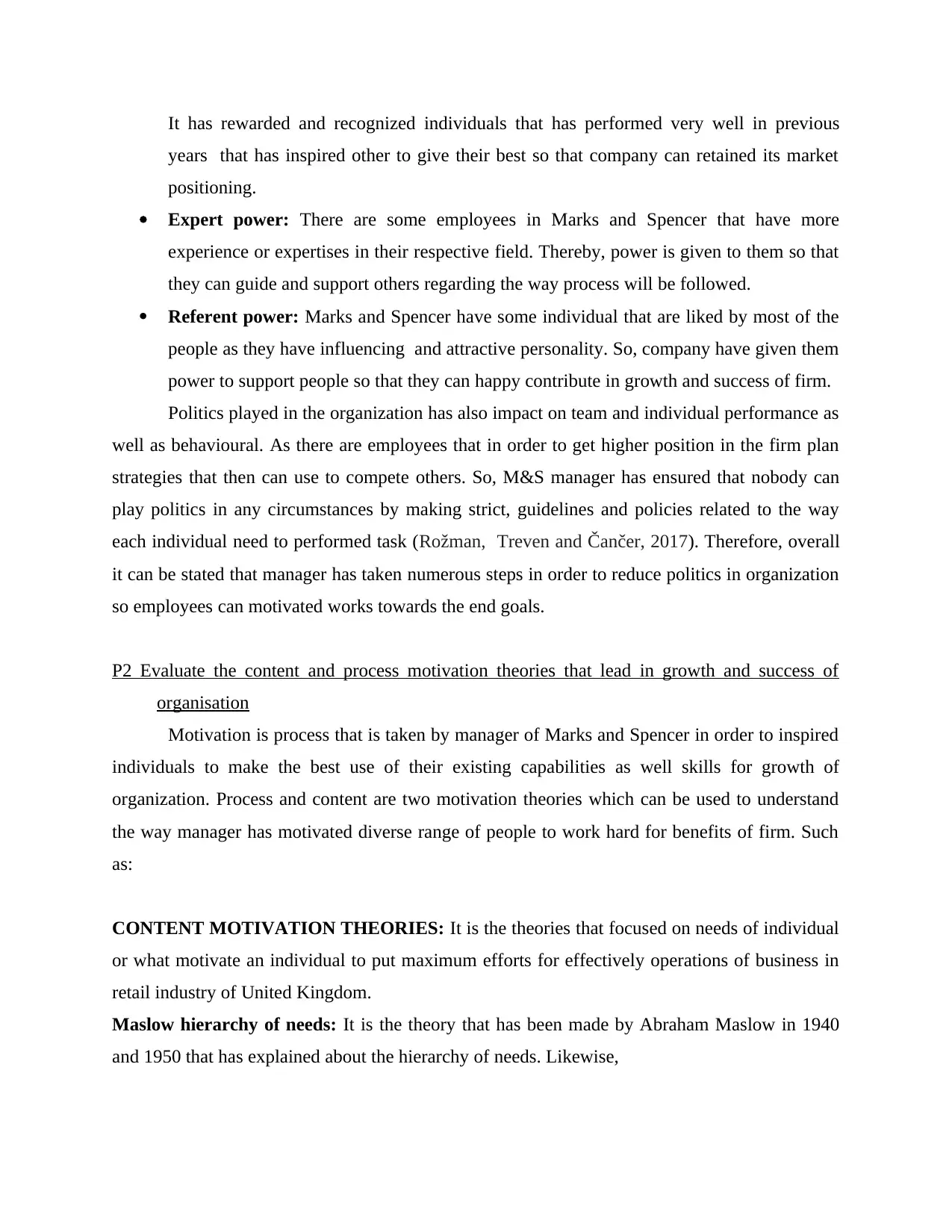
It has rewarded and recognized individuals that has performed very well in previous
years that has inspired other to give their best so that company can retained its market
positioning.
Expert power: There are some employees in Marks and Spencer that have more
experience or expertises in their respective field. Thereby, power is given to them so that
they can guide and support others regarding the way process will be followed.
Referent power: Marks and Spencer have some individual that are liked by most of the
people as they have influencing and attractive personality. So, company have given them
power to support people so that they can happy contribute in growth and success of firm.
Politics played in the organization has also impact on team and individual performance as
well as behavioural. As there are employees that in order to get higher position in the firm plan
strategies that then can use to compete others. So, M&S manager has ensured that nobody can
play politics in any circumstances by making strict, guidelines and policies related to the way
each individual need to performed task (Rožman, Treven and Čančer, 2017). Therefore, overall
it can be stated that manager has taken numerous steps in order to reduce politics in organization
so employees can motivated works towards the end goals.
P2 Evaluate the content and process motivation theories that lead in growth and success of
organisation
Motivation is process that is taken by manager of Marks and Spencer in order to inspired
individuals to make the best use of their existing capabilities as well skills for growth of
organization. Process and content are two motivation theories which can be used to understand
the way manager has motivated diverse range of people to work hard for benefits of firm. Such
as:
CONTENT MOTIVATION THEORIES: It is the theories that focused on needs of individual
or what motivate an individual to put maximum efforts for effectively operations of business in
retail industry of United Kingdom.
Maslow hierarchy of needs: It is the theory that has been made by Abraham Maslow in 1940
and 1950 that has explained about the hierarchy of needs. Likewise,
years that has inspired other to give their best so that company can retained its market
positioning.
Expert power: There are some employees in Marks and Spencer that have more
experience or expertises in their respective field. Thereby, power is given to them so that
they can guide and support others regarding the way process will be followed.
Referent power: Marks and Spencer have some individual that are liked by most of the
people as they have influencing and attractive personality. So, company have given them
power to support people so that they can happy contribute in growth and success of firm.
Politics played in the organization has also impact on team and individual performance as
well as behavioural. As there are employees that in order to get higher position in the firm plan
strategies that then can use to compete others. So, M&S manager has ensured that nobody can
play politics in any circumstances by making strict, guidelines and policies related to the way
each individual need to performed task (Rožman, Treven and Čančer, 2017). Therefore, overall
it can be stated that manager has taken numerous steps in order to reduce politics in organization
so employees can motivated works towards the end goals.
P2 Evaluate the content and process motivation theories that lead in growth and success of
organisation
Motivation is process that is taken by manager of Marks and Spencer in order to inspired
individuals to make the best use of their existing capabilities as well skills for growth of
organization. Process and content are two motivation theories which can be used to understand
the way manager has motivated diverse range of people to work hard for benefits of firm. Such
as:
CONTENT MOTIVATION THEORIES: It is the theories that focused on needs of individual
or what motivate an individual to put maximum efforts for effectively operations of business in
retail industry of United Kingdom.
Maslow hierarchy of needs: It is the theory that has been made by Abraham Maslow in 1940
and 1950 that has explained about the hierarchy of needs. Likewise,
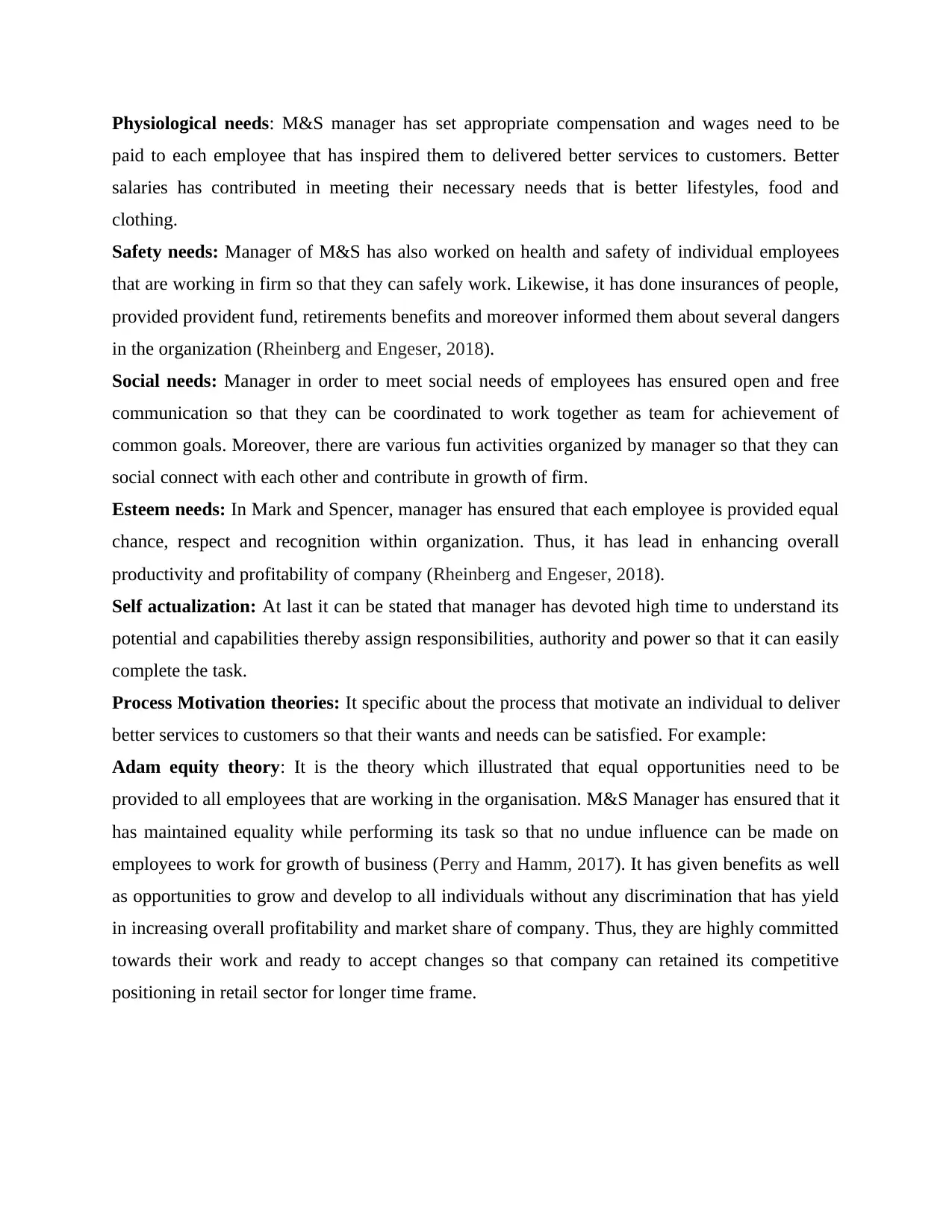
Physiological needs: M&S manager has set appropriate compensation and wages need to be
paid to each employee that has inspired them to delivered better services to customers. Better
salaries has contributed in meeting their necessary needs that is better lifestyles, food and
clothing.
Safety needs: Manager of M&S has also worked on health and safety of individual employees
that are working in firm so that they can safely work. Likewise, it has done insurances of people,
provided provident fund, retirements benefits and moreover informed them about several dangers
in the organization (Rheinberg and Engeser, 2018).
Social needs: Manager in order to meet social needs of employees has ensured open and free
communication so that they can be coordinated to work together as team for achievement of
common goals. Moreover, there are various fun activities organized by manager so that they can
social connect with each other and contribute in growth of firm.
Esteem needs: In Mark and Spencer, manager has ensured that each employee is provided equal
chance, respect and recognition within organization. Thus, it has lead in enhancing overall
productivity and profitability of company (Rheinberg and Engeser, 2018).
Self actualization: At last it can be stated that manager has devoted high time to understand its
potential and capabilities thereby assign responsibilities, authority and power so that it can easily
complete the task.
Process Motivation theories: It specific about the process that motivate an individual to deliver
better services to customers so that their wants and needs can be satisfied. For example:
Adam equity theory: It is the theory which illustrated that equal opportunities need to be
provided to all employees that are working in the organisation. M&S Manager has ensured that it
has maintained equality while performing its task so that no undue influence can be made on
employees to work for growth of business (Perry and Hamm, 2017). It has given benefits as well
as opportunities to grow and develop to all individuals without any discrimination that has yield
in increasing overall profitability and market share of company. Thus, they are highly committed
towards their work and ready to accept changes so that company can retained its competitive
positioning in retail sector for longer time frame.
paid to each employee that has inspired them to delivered better services to customers. Better
salaries has contributed in meeting their necessary needs that is better lifestyles, food and
clothing.
Safety needs: Manager of M&S has also worked on health and safety of individual employees
that are working in firm so that they can safely work. Likewise, it has done insurances of people,
provided provident fund, retirements benefits and moreover informed them about several dangers
in the organization (Rheinberg and Engeser, 2018).
Social needs: Manager in order to meet social needs of employees has ensured open and free
communication so that they can be coordinated to work together as team for achievement of
common goals. Moreover, there are various fun activities organized by manager so that they can
social connect with each other and contribute in growth of firm.
Esteem needs: In Mark and Spencer, manager has ensured that each employee is provided equal
chance, respect and recognition within organization. Thus, it has lead in enhancing overall
productivity and profitability of company (Rheinberg and Engeser, 2018).
Self actualization: At last it can be stated that manager has devoted high time to understand its
potential and capabilities thereby assign responsibilities, authority and power so that it can easily
complete the task.
Process Motivation theories: It specific about the process that motivate an individual to deliver
better services to customers so that their wants and needs can be satisfied. For example:
Adam equity theory: It is the theory which illustrated that equal opportunities need to be
provided to all employees that are working in the organisation. M&S Manager has ensured that it
has maintained equality while performing its task so that no undue influence can be made on
employees to work for growth of business (Perry and Hamm, 2017). It has given benefits as well
as opportunities to grow and develop to all individuals without any discrimination that has yield
in increasing overall profitability and market share of company. Thus, they are highly committed
towards their work and ready to accept changes so that company can retained its competitive
positioning in retail sector for longer time frame.
⊘ This is a preview!⊘
Do you want full access?
Subscribe today to unlock all pages.

Trusted by 1+ million students worldwide
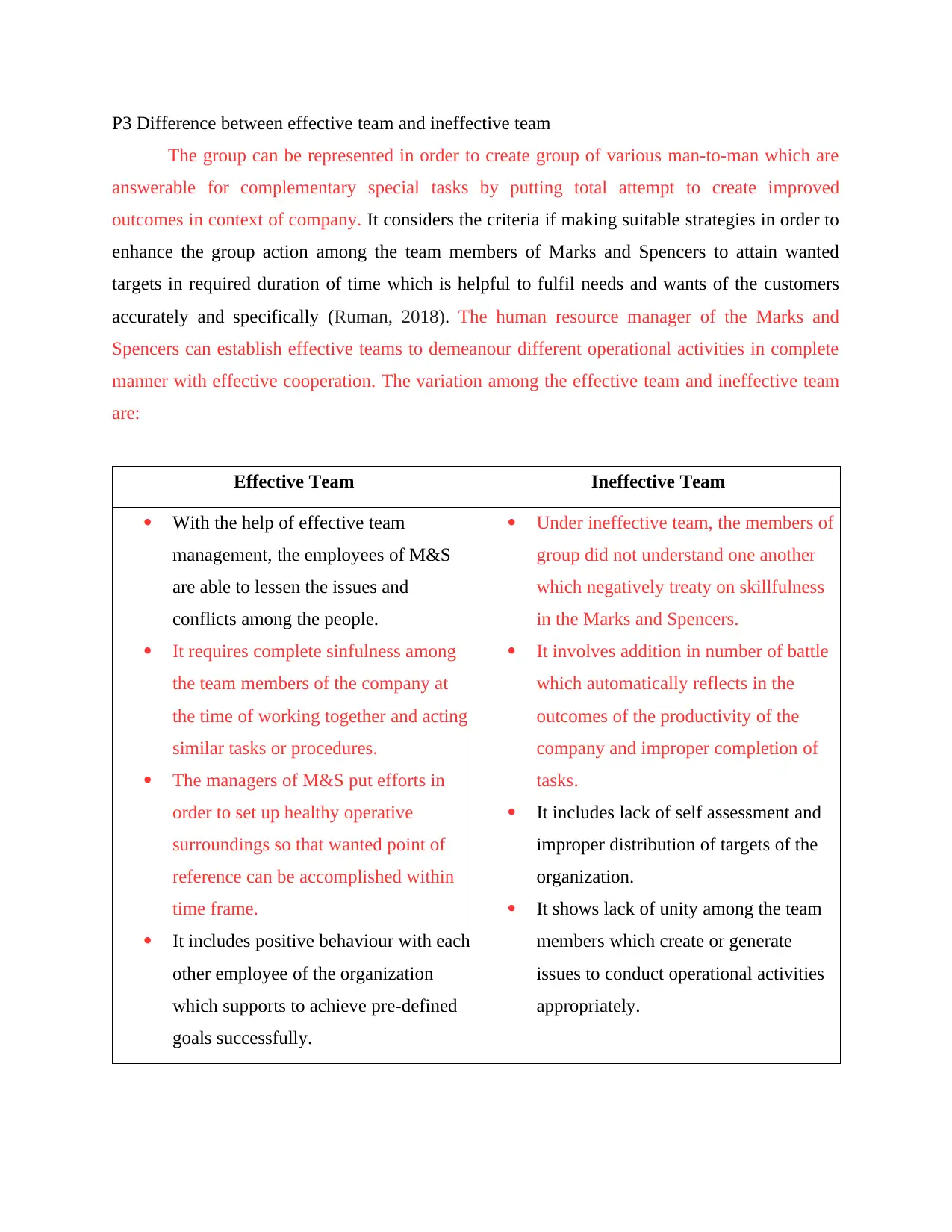
P3 Difference between effective team and ineffective team
The group can be represented in order to create group of various man-to-man which are
answerable for complementary special tasks by putting total attempt to create improved
outcomes in context of company. It considers the criteria if making suitable strategies in order to
enhance the group action among the team members of Marks and Spencers to attain wanted
targets in required duration of time which is helpful to fulfil needs and wants of the customers
accurately and specifically (Ruman, 2018). The human resource manager of the Marks and
Spencers can establish effective teams to demeanour different operational activities in complete
manner with effective cooperation. The variation among the effective team and ineffective team
are:
Effective Team Ineffective Team
With the help of effective team
management, the employees of M&S
are able to lessen the issues and
conflicts among the people.
It requires complete sinfulness among
the team members of the company at
the time of working together and acting
similar tasks or procedures.
The managers of M&S put efforts in
order to set up healthy operative
surroundings so that wanted point of
reference can be accomplished within
time frame.
It includes positive behaviour with each
other employee of the organization
which supports to achieve pre-defined
goals successfully.
Under ineffective team, the members of
group did not understand one another
which negatively treaty on skillfulness
in the Marks and Spencers.
It involves addition in number of battle
which automatically reflects in the
outcomes of the productivity of the
company and improper completion of
tasks.
It includes lack of self assessment and
improper distribution of targets of the
organization.
It shows lack of unity among the team
members which create or generate
issues to conduct operational activities
appropriately.
The group can be represented in order to create group of various man-to-man which are
answerable for complementary special tasks by putting total attempt to create improved
outcomes in context of company. It considers the criteria if making suitable strategies in order to
enhance the group action among the team members of Marks and Spencers to attain wanted
targets in required duration of time which is helpful to fulfil needs and wants of the customers
accurately and specifically (Ruman, 2018). The human resource manager of the Marks and
Spencers can establish effective teams to demeanour different operational activities in complete
manner with effective cooperation. The variation among the effective team and ineffective team
are:
Effective Team Ineffective Team
With the help of effective team
management, the employees of M&S
are able to lessen the issues and
conflicts among the people.
It requires complete sinfulness among
the team members of the company at
the time of working together and acting
similar tasks or procedures.
The managers of M&S put efforts in
order to set up healthy operative
surroundings so that wanted point of
reference can be accomplished within
time frame.
It includes positive behaviour with each
other employee of the organization
which supports to achieve pre-defined
goals successfully.
Under ineffective team, the members of
group did not understand one another
which negatively treaty on skillfulness
in the Marks and Spencers.
It involves addition in number of battle
which automatically reflects in the
outcomes of the productivity of the
company and improper completion of
tasks.
It includes lack of self assessment and
improper distribution of targets of the
organization.
It shows lack of unity among the team
members which create or generate
issues to conduct operational activities
appropriately.
Paraphrase This Document
Need a fresh take? Get an instant paraphrase of this document with our AI Paraphraser
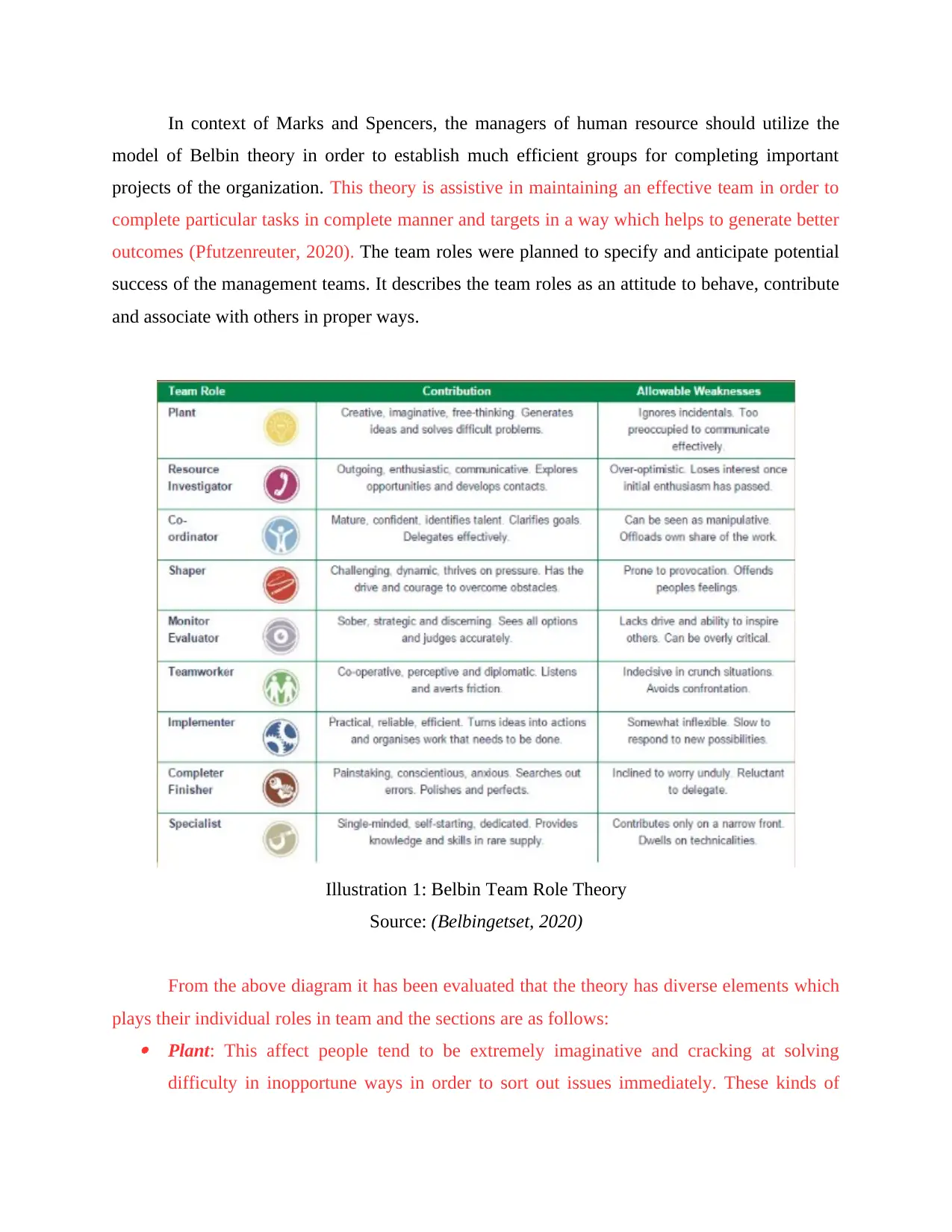
In context of Marks and Spencers, the managers of human resource should utilize the
model of Belbin theory in order to establish much efficient groups for completing important
projects of the organization. This theory is assistive in maintaining an effective team in order to
complete particular tasks in complete manner and targets in a way which helps to generate better
outcomes (Pfutzenreuter, 2020). The team roles were planned to specify and anticipate potential
success of the management teams. It describes the team roles as an attitude to behave, contribute
and associate with others in proper ways.
From the above diagram it has been evaluated that the theory has diverse elements which
plays their individual roles in team and the sections are as follows: Plant: This affect people tend to be extremely imaginative and cracking at solving
difficulty in inopportune ways in order to sort out issues immediately. These kinds of
Illustration 1: Belbin Team Role Theory
Source: (Belbingetset, 2020)
model of Belbin theory in order to establish much efficient groups for completing important
projects of the organization. This theory is assistive in maintaining an effective team in order to
complete particular tasks in complete manner and targets in a way which helps to generate better
outcomes (Pfutzenreuter, 2020). The team roles were planned to specify and anticipate potential
success of the management teams. It describes the team roles as an attitude to behave, contribute
and associate with others in proper ways.
From the above diagram it has been evaluated that the theory has diverse elements which
plays their individual roles in team and the sections are as follows: Plant: This affect people tend to be extremely imaginative and cracking at solving
difficulty in inopportune ways in order to sort out issues immediately. These kinds of
Illustration 1: Belbin Team Role Theory
Source: (Belbingetset, 2020)
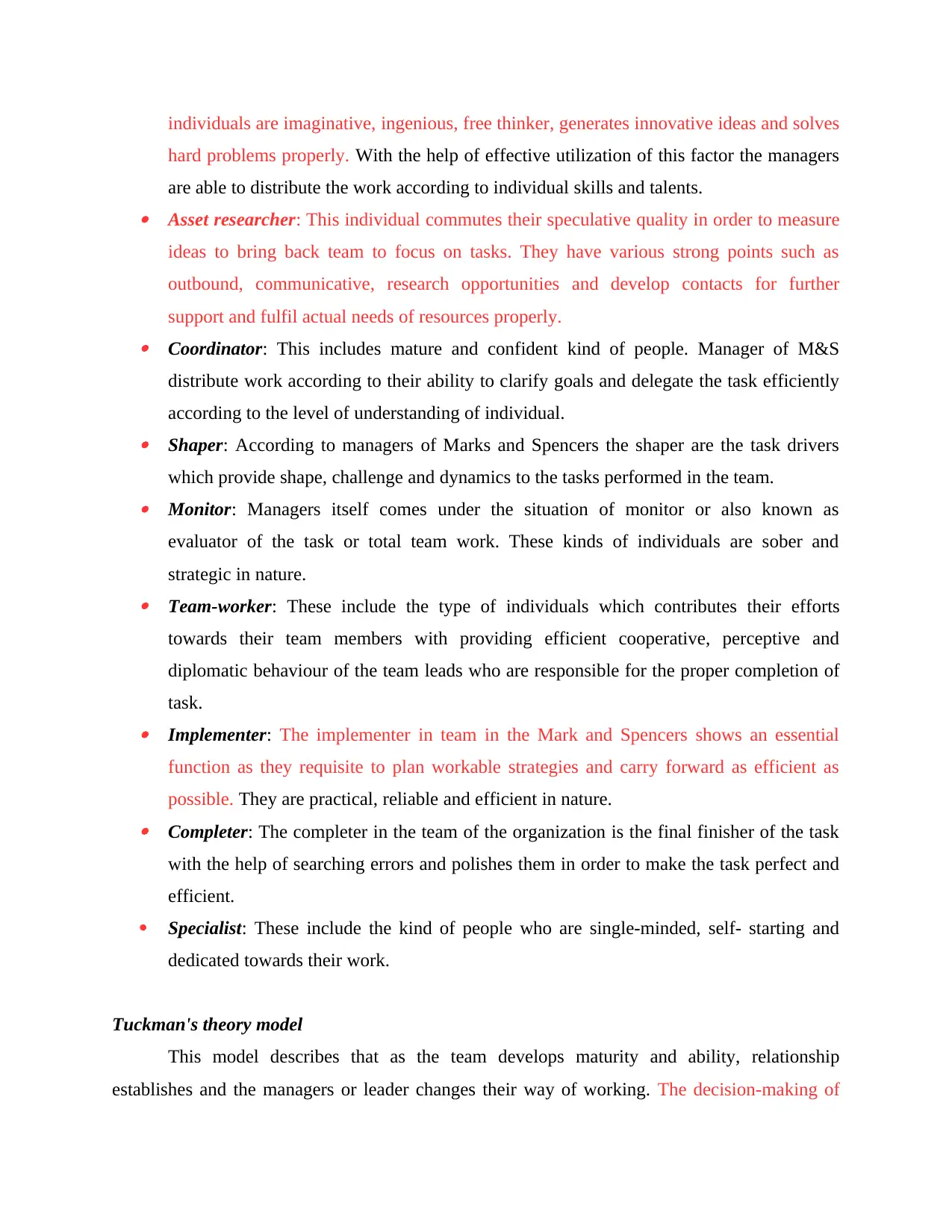
individuals are imaginative, ingenious, free thinker, generates innovative ideas and solves
hard problems properly. With the help of effective utilization of this factor the managers
are able to distribute the work according to individual skills and talents. Asset researcher: This individual commutes their speculative quality in order to measure
ideas to bring back team to focus on tasks. They have various strong points such as
outbound, communicative, research opportunities and develop contacts for further
support and fulfil actual needs of resources properly. Coordinator: This includes mature and confident kind of people. Manager of M&S
distribute work according to their ability to clarify goals and delegate the task efficiently
according to the level of understanding of individual. Shaper: According to managers of Marks and Spencers the shaper are the task drivers
which provide shape, challenge and dynamics to the tasks performed in the team. Monitor: Managers itself comes under the situation of monitor or also known as
evaluator of the task or total team work. These kinds of individuals are sober and
strategic in nature. Team-worker: These include the type of individuals which contributes their efforts
towards their team members with providing efficient cooperative, perceptive and
diplomatic behaviour of the team leads who are responsible for the proper completion of
task. Implementer: The implementer in team in the Mark and Spencers shows an essential
function as they requisite to plan workable strategies and carry forward as efficient as
possible. They are practical, reliable and efficient in nature. Completer: The completer in the team of the organization is the final finisher of the task
with the help of searching errors and polishes them in order to make the task perfect and
efficient.
Specialist: These include the kind of people who are single-minded, self- starting and
dedicated towards their work.
Tuckman's theory model
This model describes that as the team develops maturity and ability, relationship
establishes and the managers or leader changes their way of working. The decision-making of
hard problems properly. With the help of effective utilization of this factor the managers
are able to distribute the work according to individual skills and talents. Asset researcher: This individual commutes their speculative quality in order to measure
ideas to bring back team to focus on tasks. They have various strong points such as
outbound, communicative, research opportunities and develop contacts for further
support and fulfil actual needs of resources properly. Coordinator: This includes mature and confident kind of people. Manager of M&S
distribute work according to their ability to clarify goals and delegate the task efficiently
according to the level of understanding of individual. Shaper: According to managers of Marks and Spencers the shaper are the task drivers
which provide shape, challenge and dynamics to the tasks performed in the team. Monitor: Managers itself comes under the situation of monitor or also known as
evaluator of the task or total team work. These kinds of individuals are sober and
strategic in nature. Team-worker: These include the type of individuals which contributes their efforts
towards their team members with providing efficient cooperative, perceptive and
diplomatic behaviour of the team leads who are responsible for the proper completion of
task. Implementer: The implementer in team in the Mark and Spencers shows an essential
function as they requisite to plan workable strategies and carry forward as efficient as
possible. They are practical, reliable and efficient in nature. Completer: The completer in the team of the organization is the final finisher of the task
with the help of searching errors and polishes them in order to make the task perfect and
efficient.
Specialist: These include the kind of people who are single-minded, self- starting and
dedicated towards their work.
Tuckman's theory model
This model describes that as the team develops maturity and ability, relationship
establishes and the managers or leader changes their way of working. The decision-making of
⊘ This is a preview!⊘
Do you want full access?
Subscribe today to unlock all pages.

Trusted by 1+ million students worldwide
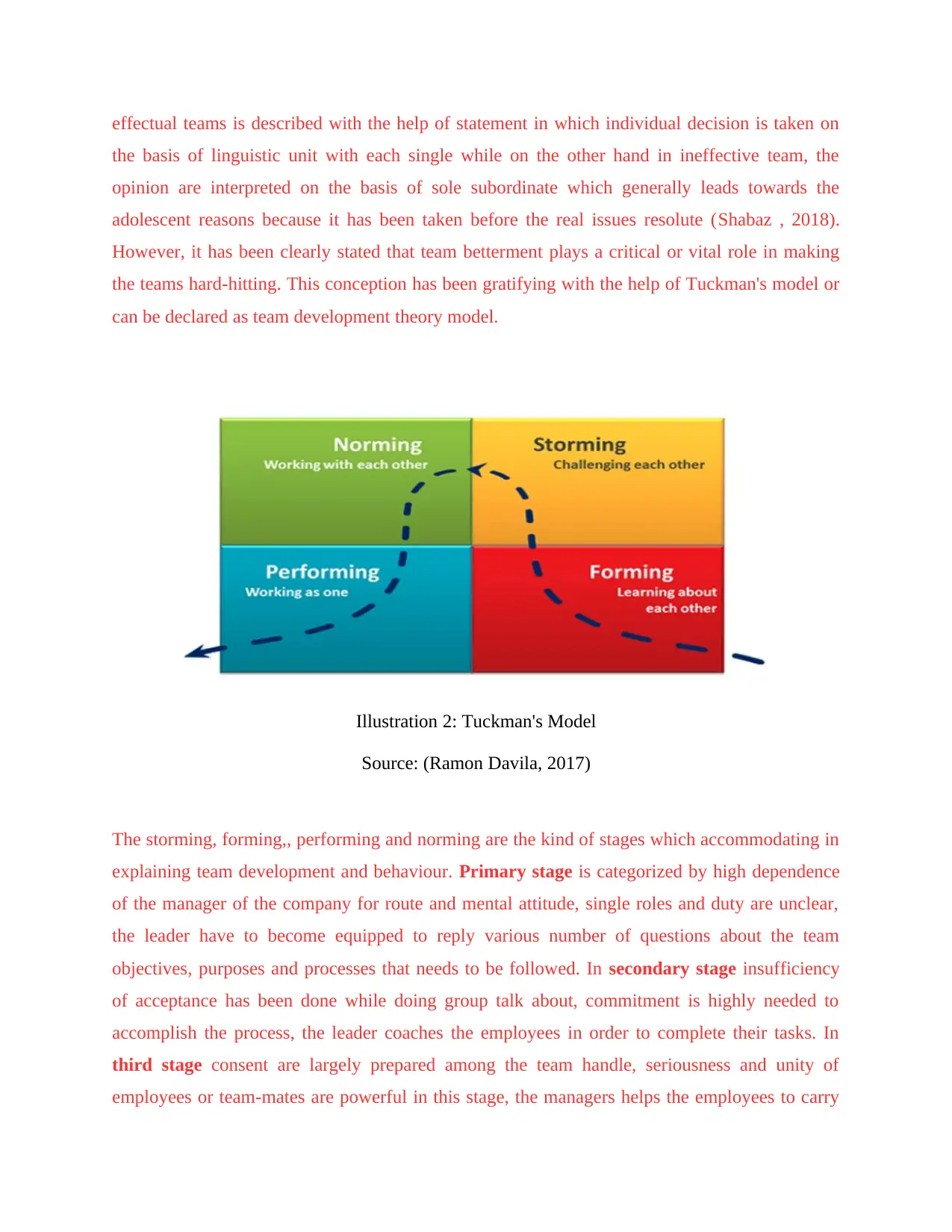
effectual teams is described with the help of statement in which individual decision is taken on
the basis of linguistic unit with each single while on the other hand in ineffective team, the
opinion are interpreted on the basis of sole subordinate which generally leads towards the
adolescent reasons because it has been taken before the real issues resolute (Shabaz , 2018).
However, it has been clearly stated that team betterment plays a critical or vital role in making
the teams hard-hitting. This conception has been gratifying with the help of Tuckman's model or
can be declared as team development theory model.
The storming, forming,, performing and norming are the kind of stages which accommodating in
explaining team development and behaviour. Primary stage is categorized by high dependence
of the manager of the company for route and mental attitude, single roles and duty are unclear,
the leader have to become equipped to reply various number of questions about the team
objectives, purposes and processes that needs to be followed. In secondary stage insufficiency
of acceptance has been done while doing group talk about, commitment is highly needed to
accomplish the process, the leader coaches the employees in order to complete their tasks. In
third stage consent are largely prepared among the team handle, seriousness and unity of
employees or team-mates are powerful in this stage, the managers helps the employees to carry
Illustration 2: Tuckman's Model
Source: (Ramon Davila, 2017)
the basis of linguistic unit with each single while on the other hand in ineffective team, the
opinion are interpreted on the basis of sole subordinate which generally leads towards the
adolescent reasons because it has been taken before the real issues resolute (Shabaz , 2018).
However, it has been clearly stated that team betterment plays a critical or vital role in making
the teams hard-hitting. This conception has been gratifying with the help of Tuckman's model or
can be declared as team development theory model.
The storming, forming,, performing and norming are the kind of stages which accommodating in
explaining team development and behaviour. Primary stage is categorized by high dependence
of the manager of the company for route and mental attitude, single roles and duty are unclear,
the leader have to become equipped to reply various number of questions about the team
objectives, purposes and processes that needs to be followed. In secondary stage insufficiency
of acceptance has been done while doing group talk about, commitment is highly needed to
accomplish the process, the leader coaches the employees in order to complete their tasks. In
third stage consent are largely prepared among the team handle, seriousness and unity of
employees or team-mates are powerful in this stage, the managers helps the employees to carry
Illustration 2: Tuckman's Model
Source: (Ramon Davila, 2017)
Paraphrase This Document
Need a fresh take? Get an instant paraphrase of this document with our AI Paraphraser
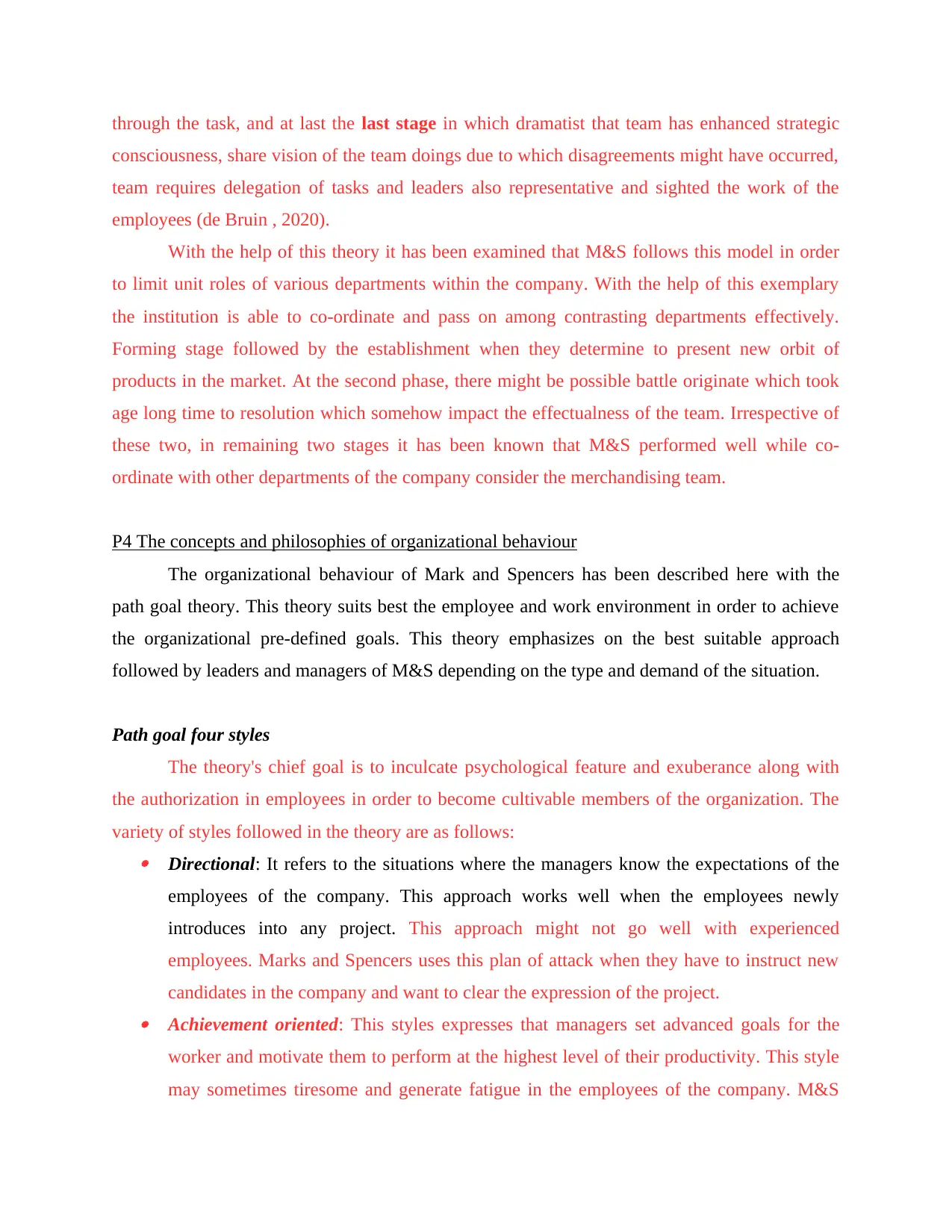
through the task, and at last the last stage in which dramatist that team has enhanced strategic
consciousness, share vision of the team doings due to which disagreements might have occurred,
team requires delegation of tasks and leaders also representative and sighted the work of the
employees (de Bruin , 2020).
With the help of this theory it has been examined that M&S follows this model in order
to limit unit roles of various departments within the company. With the help of this exemplary
the institution is able to co-ordinate and pass on among contrasting departments effectively.
Forming stage followed by the establishment when they determine to present new orbit of
products in the market. At the second phase, there might be possible battle originate which took
age long time to resolution which somehow impact the effectualness of the team. Irrespective of
these two, in remaining two stages it has been known that M&S performed well while co-
ordinate with other departments of the company consider the merchandising team.
P4 The concepts and philosophies of organizational behaviour
The organizational behaviour of Mark and Spencers has been described here with the
path goal theory. This theory suits best the employee and work environment in order to achieve
the organizational pre-defined goals. This theory emphasizes on the best suitable approach
followed by leaders and managers of M&S depending on the type and demand of the situation.
Path goal four styles
The theory's chief goal is to inculcate psychological feature and exuberance along with
the authorization in employees in order to become cultivable members of the organization. The
variety of styles followed in the theory are as follows: Directional: It refers to the situations where the managers know the expectations of the
employees of the company. This approach works well when the employees newly
introduces into any project. This approach might not go well with experienced
employees. Marks and Spencers uses this plan of attack when they have to instruct new
candidates in the company and want to clear the expression of the project. Achievement oriented: This styles expresses that managers set advanced goals for the
worker and motivate them to perform at the highest level of their productivity. This style
may sometimes tiresome and generate fatigue in the employees of the company. M&S
consciousness, share vision of the team doings due to which disagreements might have occurred,
team requires delegation of tasks and leaders also representative and sighted the work of the
employees (de Bruin , 2020).
With the help of this theory it has been examined that M&S follows this model in order
to limit unit roles of various departments within the company. With the help of this exemplary
the institution is able to co-ordinate and pass on among contrasting departments effectively.
Forming stage followed by the establishment when they determine to present new orbit of
products in the market. At the second phase, there might be possible battle originate which took
age long time to resolution which somehow impact the effectualness of the team. Irrespective of
these two, in remaining two stages it has been known that M&S performed well while co-
ordinate with other departments of the company consider the merchandising team.
P4 The concepts and philosophies of organizational behaviour
The organizational behaviour of Mark and Spencers has been described here with the
path goal theory. This theory suits best the employee and work environment in order to achieve
the organizational pre-defined goals. This theory emphasizes on the best suitable approach
followed by leaders and managers of M&S depending on the type and demand of the situation.
Path goal four styles
The theory's chief goal is to inculcate psychological feature and exuberance along with
the authorization in employees in order to become cultivable members of the organization. The
variety of styles followed in the theory are as follows: Directional: It refers to the situations where the managers know the expectations of the
employees of the company. This approach works well when the employees newly
introduces into any project. This approach might not go well with experienced
employees. Marks and Spencers uses this plan of attack when they have to instruct new
candidates in the company and want to clear the expression of the project. Achievement oriented: This styles expresses that managers set advanced goals for the
worker and motivate them to perform at the highest level of their productivity. This style
may sometimes tiresome and generate fatigue in the employees of the company. M&S
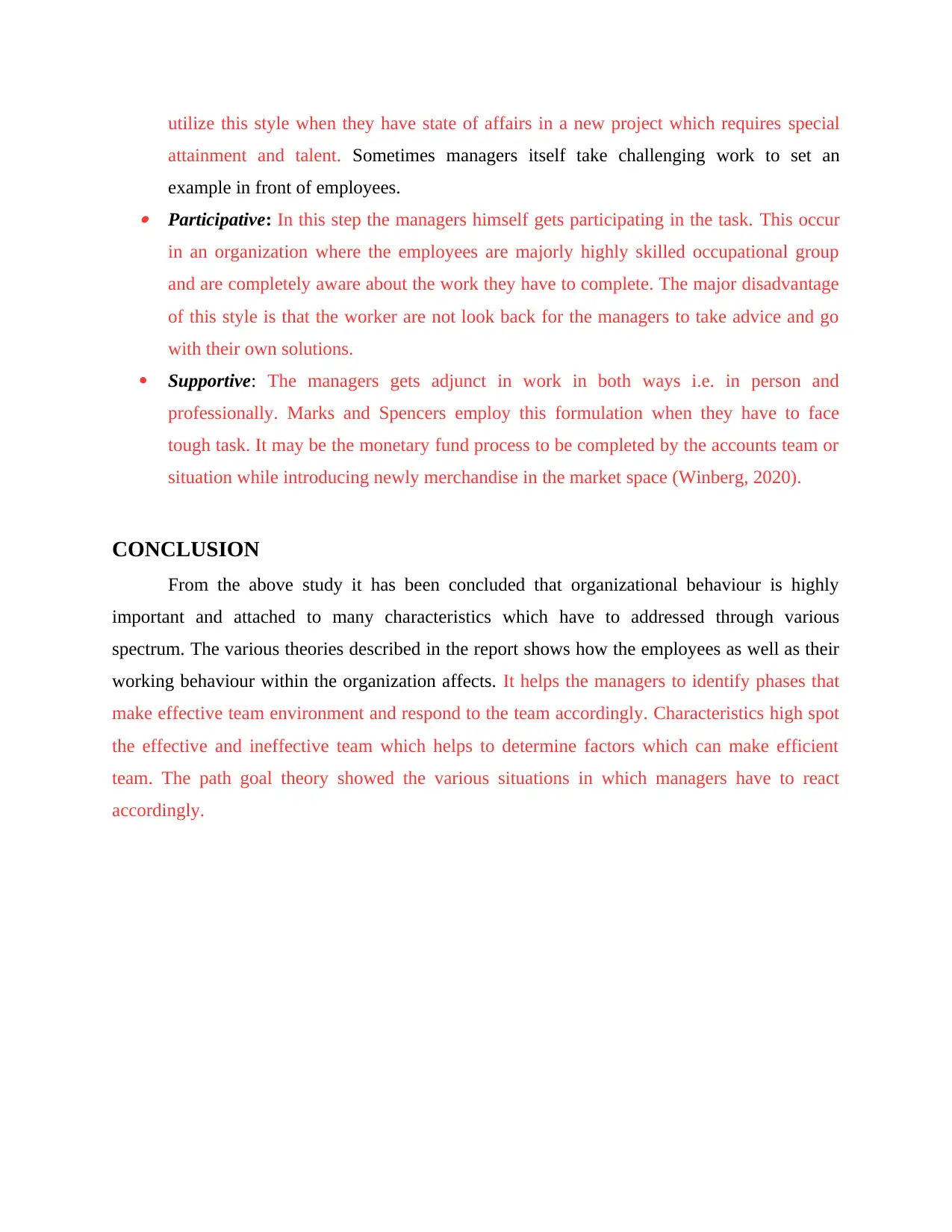
utilize this style when they have state of affairs in a new project which requires special
attainment and talent. Sometimes managers itself take challenging work to set an
example in front of employees. Participative: In this step the managers himself gets participating in the task. This occur
in an organization where the employees are majorly highly skilled occupational group
and are completely aware about the work they have to complete. The major disadvantage
of this style is that the worker are not look back for the managers to take advice and go
with their own solutions.
Supportive: The managers gets adjunct in work in both ways i.e. in person and
professionally. Marks and Spencers employ this formulation when they have to face
tough task. It may be the monetary fund process to be completed by the accounts team or
situation while introducing newly merchandise in the market space (Winberg, 2020).
CONCLUSION
From the above study it has been concluded that organizational behaviour is highly
important and attached to many characteristics which have to addressed through various
spectrum. The various theories described in the report shows how the employees as well as their
working behaviour within the organization affects. It helps the managers to identify phases that
make effective team environment and respond to the team accordingly. Characteristics high spot
the effective and ineffective team which helps to determine factors which can make efficient
team. The path goal theory showed the various situations in which managers have to react
accordingly.
attainment and talent. Sometimes managers itself take challenging work to set an
example in front of employees. Participative: In this step the managers himself gets participating in the task. This occur
in an organization where the employees are majorly highly skilled occupational group
and are completely aware about the work they have to complete. The major disadvantage
of this style is that the worker are not look back for the managers to take advice and go
with their own solutions.
Supportive: The managers gets adjunct in work in both ways i.e. in person and
professionally. Marks and Spencers employ this formulation when they have to face
tough task. It may be the monetary fund process to be completed by the accounts team or
situation while introducing newly merchandise in the market space (Winberg, 2020).
CONCLUSION
From the above study it has been concluded that organizational behaviour is highly
important and attached to many characteristics which have to addressed through various
spectrum. The various theories described in the report shows how the employees as well as their
working behaviour within the organization affects. It helps the managers to identify phases that
make effective team environment and respond to the team accordingly. Characteristics high spot
the effective and ineffective team which helps to determine factors which can make efficient
team. The path goal theory showed the various situations in which managers have to react
accordingly.
⊘ This is a preview!⊘
Do you want full access?
Subscribe today to unlock all pages.

Trusted by 1+ million students worldwide
1 out of 14
Related Documents
Your All-in-One AI-Powered Toolkit for Academic Success.
+13062052269
info@desklib.com
Available 24*7 on WhatsApp / Email
![[object Object]](/_next/static/media/star-bottom.7253800d.svg)
Unlock your academic potential
Copyright © 2020–2025 A2Z Services. All Rights Reserved. Developed and managed by ZUCOL.





